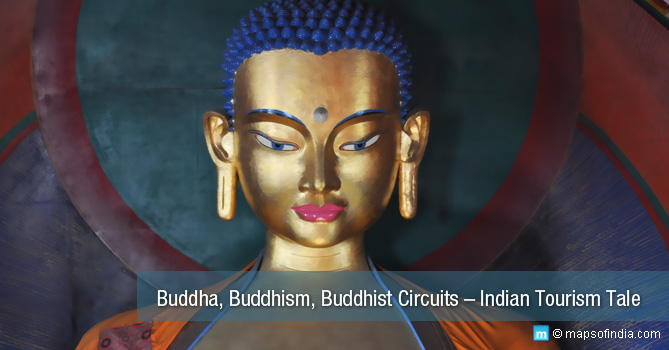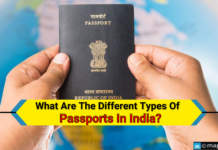What is Buddhist Circuit?
The holy places of Buddhism, where Lord Buddha was born and He taught, preached, and attained ‘Enlightenment’ and ‘Nirvana’, are termed as Buddhist Circuit. These are the spiritual homes of Buddhism, housing temples and monasteries of high religious significances, where followers of Buddhism associate themselves with the teachings of Lord Buddha. Buddhist Circuit has evolved as tourist centres for not only the followers of Buddhism but also others.
Buddhist Circuit in India: Important places
In India, Buddhist Circuit is in Bodhgaya, Vaishali and Rajgir in Bihar, Sarnath in Varanasi, Shravasti and Kushinagar in Uttar Pradesh. All these are the main pilgrimage centres for Buddhism in India. Let us get an idea of these places in Buddhist Circuit:
Bodhgaya: Located in Bihar, this is the place where Prince Siddhartha found enlightenment under the Bodhi Tree. After meditating for 49 days, he became Lord Buddha, the Enlightened One. In Bodhgaya, the important tourist attractions are Bodhi Tree, Mahabodhi Temple, Vajrasana Throne donated by King Ashoka, Muchalinda Lake, Animesh Lochan Chaitya, some other holy trees like Ratnachankramana, Ratnagaraha, Ajapala Nigrodha and Rajyatna. It also has a number of monasteries, established by Buddhists of Myanmar, Sri Lanka, Japan, Thailand, etc. Hence, it is a major attraction for foreign tourists.
Sarnath: This is the place where Lord Buddha gave his first sermon. This was given after he achieved enlightenment. Sarnath is about 10 km from the holy city of Varanasi. It was at Sarnath that Buddha established his sangha or first disciples to promote his new doctrine. The proud symbol of India, the famous lion capital pillar or the Ashoka pillar was erected by King Ashoka originally at Dhamekh Stupa in Sarnath. You also can see Chaukhandi Stupa, Mulagandha Kuti Vihar and Sarnath Ashram here.
Kushinagar: This place is located in the Gorakhpur district in eastern Uttar Pradesh, India. It is en route to Kapilavastu, the place where Lord Buddha fell ill and died in 543 BC. It is said that the mortal remains of Lord Buddha were distributed by King Ashoka into more than 80,000 stupas across his kingdom and outside. Important places to see here are Mukatanabandhana Stupa and the reclining Buddha statue in red sandstone. Other attractions are Wat Thai Temple, Chinese Temple, Japanese Temple, Mahanirvana Temple, etc. This is the place where Lord Buddha attained salvation.
Vaishali: This was the place where Lord Buddha gave his last sermon. The place is 60 km away from the capital of Bihar, Patna. It is said that Buddha told his disciple Ananda about his imminent demise in this place. The place is also known for the second Buddhist Council, which took place about 110 years later.
Rajgir: Rajgir, about 70 km from Bodhgaya, was the Lord’s monsoon retreat for 12 years. While spreading his doctrine, He preached about the precepts of Lotus Sutra and the Perfection of Wisdom Sutra. The location was Gridhakuta Hill in Rajgir. The first Buddhist council was held at the Saptaparni Caves on Vaibhar Hill in Rajgir. The teachings of Buddha were compiled after his death and preached in the council. The world-renowned university of Nalanda is another important site to visit in Rajgir.
Shravasti: Shravasti was Buddha’s favourite rainy season retreat. It was located about 150 km from Lucknow in Uttar Pradesh and it was at this place Buddha performed his first miracle.
Lumbini: Situated in the Rupandehi district of Nepal, Lumbini is the place where Lord Buddha was born. Today, it is an important Buddhist pilgrimage site. Being a neighbour country, Lumbini is also sometimes included in the Buddhist Circuit in India by tour operators.
Buddhist Circuit Route
Lumbini →Bodhgaya→Sarnath→Kushinagar
From Lumbini in Nepal, where Lord Buddha was born, to Bodhgaya, where He attained enlightenment, to Sarnath, where He preached, to Kushinagar where He achieved salvation.
Plans for Development
In July 2014, Union Finance Minister Arun Jaitley announced that the route and areas covering important Buddhist destinations of the country, popularly termed as Buddhist Circuit, will be developed into a high class tourist centre with all modern amenities. The objective is to attract more tourists from all over the world and increase the growth of the tourism industry. It is considered a great initiative by tour operators, with the expectation of a big boom.
Need For Development of Buddhist Circuit
In the past, the tourism departments of UP and Bihar had taken various measures to promote tourism, but it was unsuccessful. Majority of the tourists preferred to visit only Bodhgaya and Sarnath, while other Buddhist destinations were neglected. According to studies, the modern-age tourists have high-spending capacities. Also, there are many Buddhist travellers who are keen to visit all the places in Buddhist Circuit. However, lack of proper infrastructure and basic amenities, poor road conditions and absence of direct air connectivity have proved to be bottlenecks for Buddhist travellers and tourists to visit Buddhist Circuit.
In such a condition, Jaitley’s announcement of producing five tourist centres in Buddhist Circuit aroused hope for revival of the tourism sector. This was an expensive project, where the Union Ministry has allocated Rs 500 crore. Today, Buddhist Circuit attracts tourists from almost 16 states of India and more than 30 countries of the world. So, with further development, Buddhist Circuit can become a major tourist destination.
Other Buddhist Destinations in India
Arunachal Pradesh – Bomdila and Tawang
Sikkim – Kalimpong and Rumtek
Jammu & Kashmir – Ladakh, Harwan, Ambarani and Parihaspura
Himachal Pradesh – Spiti, Kinnaur and Dharamshala
Haryana – Stupa at Sugh, Yamunanagar and Asangh (Jind)
Madhya Pradesh – Sardarah, Sanchi and Murakott
Maharashtra – Karala, Ellora, Kanheri, Ajanta Caves, Pitalgora and Nasik Caves
West Bengal – Darjeeling and Kolkata (Indian Museum)
Andhra Pradesh – Amravati, Salihunda, Borrah Caves and Nagarjunkonda




